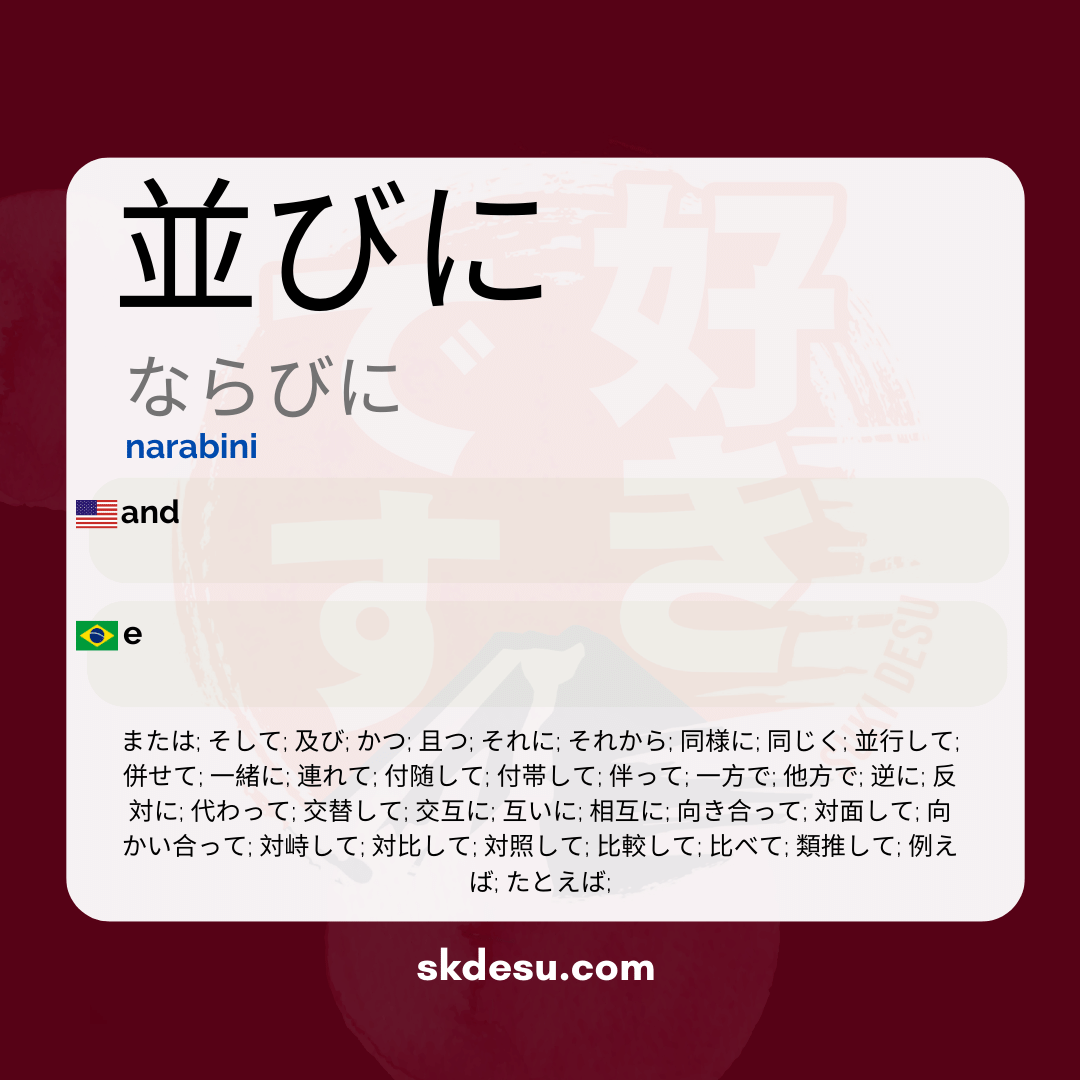Translation and Meaning of: 並びに - narabini
The Japanese word 並びに [ならびに] may seem simple at first glance, but its usage brings important nuances for those studying the language. In this article, we will explore its meaning, origin, and practical applications in everyday Japanese. Furthermore, we will understand how this conjunction is culturally perceived and in which contexts it appears most frequently.
If you have come across 並びに in formal texts or documents, you know that it is not so common in casual conversations. Here at Suki Nihongo, we'll uncover the details of this word so that you can use it confidently, whether in advanced studies or in interpreting written materials.
Meaning and usage of 並びに
並びに is a conjunction that means "and," "as well as," or "together with." Unlike other particles such as と or や, it carries a more formal tone and is often used in official documents, contracts, and legal texts. Its main function is to list items in an organized and hierarchical manner.
An interesting aspect of 並びに is that it often connects elements that have a logical or similarity relationship. For example, in a employment contract, you may find phrases like "給料並びに福利厚生" (salary and benefits), where the two terms are directly related in a professional context.
Origin and composition of kanji
The kanji 並 (nara) means "to align" or "to put in a line," while びに is a grammatical particle that reinforces the idea of connection. Together, they form a word that literally suggests "align and connect." This mental image can help in memorizing the term, especially when we think of its use to list items in an orderly manner.
Interestingly, the character 並 appears in other words such as 並行 (parallel) and 並列 (in series), always maintaining this notion of sequential organization. This semantic consistency makes it easier to understand why 並びに is used to enumerate elements with a certain formality.
Contexts of use and frequency
Unlike everyday particles like と or や, 並びに primarily appears in written and formal contexts. Its use in daily conversations is rare, which explains why many Japanese learners only encounter it in more advanced stages of study. Government documents, technical manuals, and academic texts are where it stands out the most.
A valuable tip for recognizing 並びに in real contexts is to pay attention to materials such as rental contracts, business regulations, or even public notices. In these situations, it serves to connect important information clearly and unequivocally, leaving no room for ambiguities.
Tips for memorization and correct usage
To fix 並びに in memory, an effective strategy is to associate it with specific situations where formality is necessary. Imagine writing an important document or reading the clauses of a contract - these are the ideal scenarios to employ this conjunction. Creating flashcards with real examples can also accelerate the learning process.
It is worth noting that, despite its utility in formal contexts, 並びに does not completely replace other conjunctive particles. The secret is to understand when each one is appropriate: while と and や are versatile in everyday language, 並びに has its guaranteed place in technical and bureaucratic language.
Vocabulary
Expand your vocabulary with related words:
Synonyms and similar words
- または (matawa) - Please provide the text you'd like me to translate.
- そして (soshite) - and then
- 及び (oyobi) - and also (formal)
- かつ (katsu) - and besides (formal)
- それに (soreni) - besides that
- それから (sorekara) - then, next
- 同様に (douyou ni) - In the same way
- 同じく (onajiku) - in the same way
- 並行して (heikou shite) - parallelly
- 併せて (awase te) - together with, agreed
- 一緒に (issho ni) - together
- 連れて (zurete) - carrying, accompanying
- 付随して (fuzui shite) - accompanying, being associated
- 伴って (伴って) - accompanying, being accompanied
- 一方で (ippou de) - on one hand, meanwhile
- 他方で (tahou de) - Por outro lado
- 逆に (gyaku ni) - inversely, on the contrary
- 反対に (hantai ni) - in contrast, conversely
- 代わって (kawatte) - in exchange, replacing
- 交替して (koutai shite) - alternating, alternating
- 交互に (kougo ni) - alternately
- 互いに (tagaini) - to each other, mutually
- 相互に (sougoni) - reciprocally, mutually
- 向き合って (mukiatte) - facing each other
- 対面して (taimen shite) - facing, face to face
- 向かい合って (mukaiatte) - facing each other
- 対峙して (taiji shite) - confronting, face to face
- 対比して (taihi shite) - comparing, contrasting
- 対照して (taishou shite) - in contrast, comparing
- 比較して (hikaku shite) - comparing
- 比べて (kurabete) - In comparison
- 類推して (ruisui shite) - making an analogy
- 例えば (tatoeba) - For example
- たとえば (tatoeba) - For example
Romaji: narabini
Kana: ならびに
Type: conjunction set
L: jlpt-n1
Translation / Meaning: I'm sorry, but I need a text or string to translate from Portuguese to English. Please provide the content you'd like me to work on.
Meaning in English: and
Definition: [Connection] At the same time, in the same way, in parallel.
Quick Access
- Vocabulary
- Writing
- Sentences
How to Write in Japanese - (並びに) narabini
See below a step-by-step guide on how to write the word by hand in Japanese. (並びに) narabini:
Example Sentences - (並びに) narabini
See below some example sentences:
Nenhum resultado encontrado.
Other Words of this Type: conjunction set
See other words from our dictionary that are also: conjunction set

